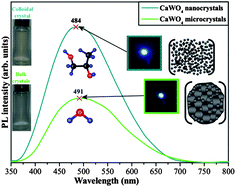Electronic structure, growth mechanism and photoluminescence of CaWO4 crystals†
Abstract
In this paper, aggregated CaWO4 micro- and

* Corresponding authors
a
Universidade Estadual Paulista, P.O. Box 355, Araraquara, SP, Brazil
E-mail:
laeciosc@bol.com.br
b Universidade Federal de São Carlos, P.O. Box 676, CEP. 13565-905, São Carlos, SP, Brazil
c IFSC-Universidade de São Paulo, P.O. Box 369, São Carlos, SP, Brazil
In this paper, aggregated CaWO4 micro- and

 Please wait while we load your content...
Something went wrong. Try again?
Please wait while we load your content...
Something went wrong. Try again?
L. S. Cavalcante, V. M. Longo, J. C. Sczancoski, M. A. P. Almeida, A. A. Batista, J. A. Varela, M. O. Orlandi, E. Longo and M. S. Li, CrystEngComm, 2012, 14, 853 DOI: 10.1039/C1CE05977G
To request permission to reproduce material from this article, please go to the Copyright Clearance Center request page.
If you are an author contributing to an RSC publication, you do not need to request permission provided correct acknowledgement is given.
If you are the author of this article, you do not need to request permission to reproduce figures and diagrams provided correct acknowledgement is given. If you want to reproduce the whole article in a third-party publication (excluding your thesis/dissertation for which permission is not required) please go to the Copyright Clearance Center request page.
Read more about how to correctly acknowledge RSC content.
 Fetching data from CrossRef.
Fetching data from CrossRef.
This may take some time to load.
Loading related content
